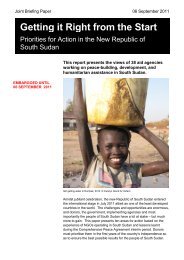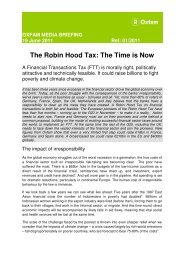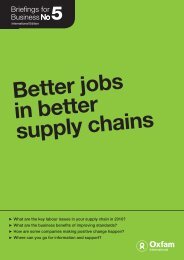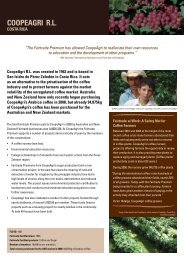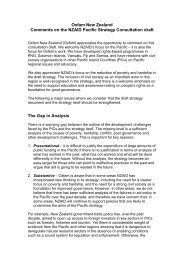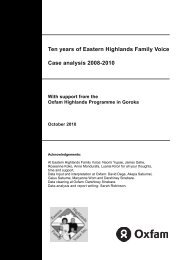Better returns for business.pdf - Oxfam New Zealand
Better returns for business.pdf - Oxfam New Zealand
Better returns for business.pdf - Oxfam New Zealand
- No tags were found...
You also want an ePaper? Increase the reach of your titles
YUMPU automatically turns print PDFs into web optimized ePapers that Google loves.
TWENTY FOURThe lack of transparency in the investmentsectorThe third major structural issue is the generallack of transparency in the investment industry.The vast majority of asset owners and assetmanagers provide little or no in<strong>for</strong>mation ontheir approaches to responsible investment;in most cases, disclosure is confined to arelatively general high-level policy. Whilethere has been some progress (e.g. 40 percent of PRI signatories now publish theresponses they provide to the annual PRIimplementation survey), 45 very few institutionalinvestors provide a coherent and completeaccount of: (a) how they give effect to theirpolicies; (b) what resources they allocate toresponsible investment; (c) what engagementthey conduct, and what outcomes result fromthis engagement; (d) how they take accountof ESG issues in their investment processesand the investment results that such a focushas provided, and (e) whether and underwhat conditions they collaborate with otherinvestors 46 . The consequence is that it is simplynot possible to assess whether an investor’sresponsible investment commitments have hadany impact on investment per<strong>for</strong>mance or socialor environmental outcomes.Lack of transparency presents two importantchallenges to the investment industry. First,given that transparency is one of the coreprinciples of the PRI, there is a real riskthat companies will push back on investordemands <strong>for</strong> more disclosure on the groundsthat investors themselves are not transparentabout how they use this in<strong>for</strong>mation. Second,the systemic lack of transparency runs the riskof undermining the credibility of initiatives suchas the PRI. If the PRI is not seen as a credibleinitiative, this will, in turn, limit the value ofthe PRI to investors. A similar argument canbe applied to individual investors. Withouttransparency on implementation, their rhetoricand policy commitments will simply not be seenas credible.“Transparency is crucial. Bothasset owners and managers shouldhave a publicly available strategythat underpins their principles andESG approach. They should bepublicly transparent on their valuesand per<strong>for</strong>mance so that peoplecan differentiate between them.”Giuseppe van der Helm,Executive director of VBDO andPresident of EUROSIF4.3 Technical barriersThe <strong>Better</strong> Returns in a <strong>Better</strong> World projectidentified a number of technical barriersthat limit the ability of investment managersto account fully <strong>for</strong> poverty reduction anddevelopment issues in their investmentprocesses. These fall into two categories:• Practical difficulties in valuing these issues and,even in situations where they can be valued,ensuring: (a) they are given appropriate weightin investment decisions, and (b) they havedesirable social outcomes.• The general absence of clear normativeframeworks (whether defined in regulation or inwidely supported codes and standards) againstwhich company per<strong>for</strong>mance can be assessedand which can <strong>for</strong>m the basis <strong>for</strong> dialoguebetween companies and their investors.MOST ASSET OWNERS AND MANAGERSPROVIDE LITTLE OR NO INFORMATION ONTHEIR APPROACHES TO RESPONSIBLEINVESTMENT. THIS MAKES IT VERYDIFFICULT TO ASSESS WHETHER THEIRRESPONSIBLE INVESTMENT STRATEGIESHAVE HAD ANY IMPACT ON PERFORMANCEOR SOCIAL OR ENVIRONMENTAL OUTCOMES.



